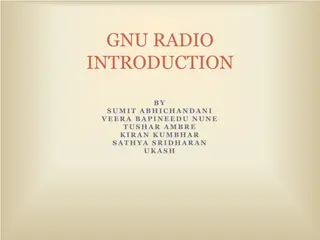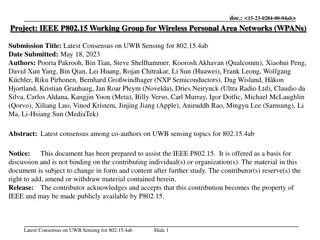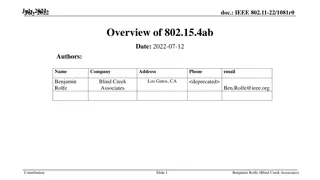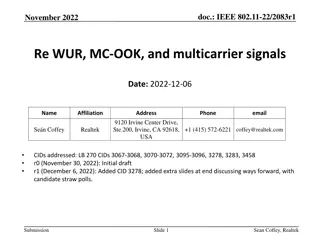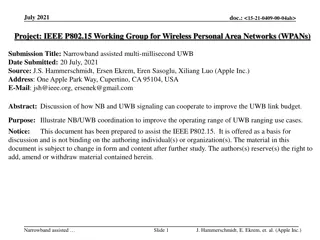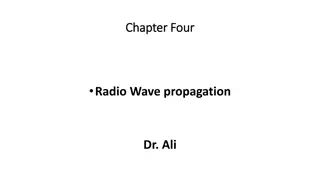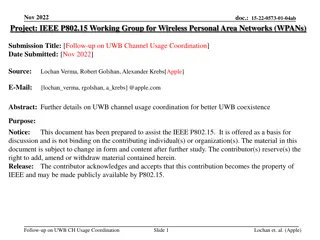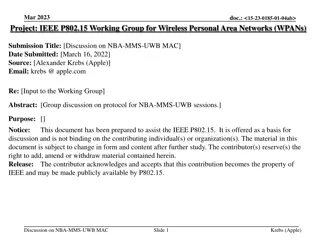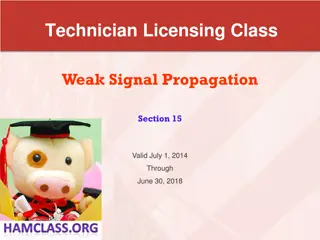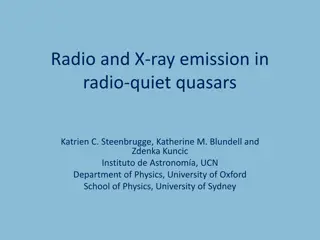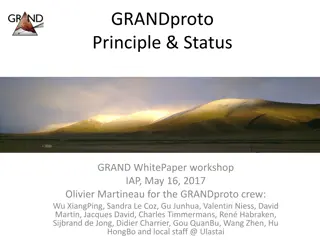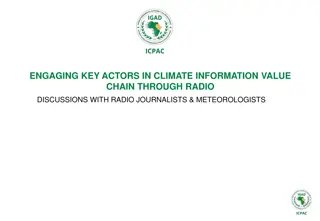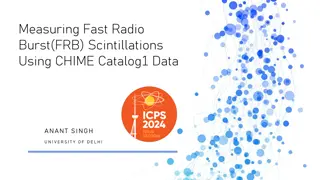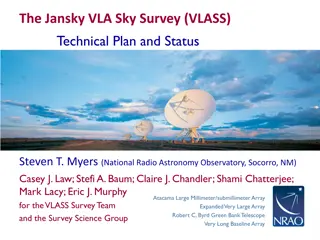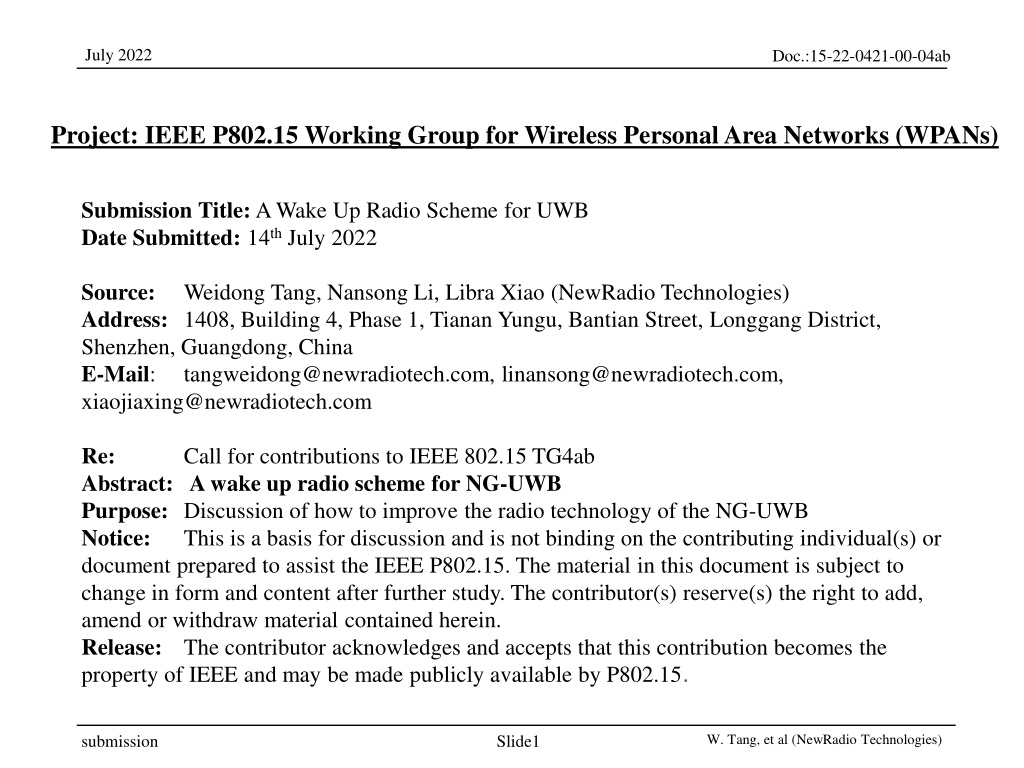
Innovative Wake-Up Radio Scheme for Next-Gen UWB Technology
Explore a cutting-edge wake-up radio scheme for NG-UWB technology, aiming to enhance radio performance for wireless personal area networks. The proposal addresses interference mitigation, coexistence improvements, backward compatibility, and power consumption reduction, among other key aspects. Stay updated with the latest advancements in UWB technology through this insightful submission.
Download Presentation

Please find below an Image/Link to download the presentation.
The content on the website is provided AS IS for your information and personal use only. It may not be sold, licensed, or shared on other websites without obtaining consent from the author. Download presentation by click this link. If you encounter any issues during the download, it is possible that the publisher has removed the file from their server.
E N D
Presentation Transcript
July 2022 Doc.:15-22-0421-00-04ab Project: IEEE P802.15 Working Group for Wireless Personal Area Networks (WPANs) Submission Title: A Wake Up Radio Scheme for UWB Date Submitted: 14thJuly 2022 Source: Address: 1408, Building 4, Phase 1, Tianan Yungu, Bantian Street, Longgang District, Shenzhen, Guangdong, China E-Mail: tangweidong@newradiotech.com, linansong@newradiotech.com, xiaojiaxing@newradiotech.com Weidong Tang, Nansong Li, Libra Xiao (NewRadio Technologies) Re: Abstract: A wake up radio scheme for NG-UWB Purpose: Discussion of how to improve the radio technology of the NG-UWB Notice: This is a basis for discussion and is not binding on the contributing individual(s) or document prepared to assist the IEEE P802.15. The material in this document is subject to change in form and content after further study. The contributor(s) reserve(s) the right to add, amend or withdraw material contained herein. Release: The contributor acknowledges and accepts that this contribution becomes the property of IEEE and may be made publicly available by P802.15. Call for contributions to IEEE 802.15 TG4ab W. Tang, et al (NewRadio Technologies) submission Slide1
July 2022 Doc.:15-22-0421-00-04ab PAR Objective The Proposed Solution (how addressed) Safeguards so that the high throughput data will not cause significant disruption to low duty-cycle ranging use cases Interference mitigation techniques to support higher density and higher traffic use cases Other coexistence improvements Backward compatibility with enhanced ranging capable devices (ERDEVs) Improved link budget and/or reduced air-time Additional channels and operating frequencies Improvements to accuracy / precision / reliability and interoperability for high-integrity ranging Improvement of wake up radio link budget Reduced complexity and power consumption A wake up radio to reduce power consumption of UWB device in sleep mode. Hybrid operation with narrowband signaling to assist UWB Enhanced native discovery and connection setup mechanisms Sensing capabilities to support presence detection and environment mapping Low-power low-latency streaming Higher data-rate streaming allowing at least 50 Mbit/s of throughput Support for peer-to-peer, peer-to-multi-peer, and station-to- infrastructure protocols Infrastructure synchronization mechanisms Low power scheme for wake up radio submission W. Tang, et al (NewRadio Technologies) Slide2
July 2022 Doc.:15-22-0421-00-04ab Previous submissions Marcus Granger-Jones. (Qorvo Inc.) UWB Wakeup Signaling <15-21-0557-01-04ab>, Nov 2021, Michael McLaughlin, Ryan Bunch Link budget analysis UWB vs NB <15-22-0094-01-04ab>, Jan 2022, Michael McLaughlin (Qorvo Inc.) Billy Verso, Carl Murray (Qorvo Inc.) The Advantages of UWB Wakeup <15-22-0282-01-04ab>, Jan 2022, Chitao Goe, Michael McLaughlin, submission W. Tang, et al (NewRadio Technologies) Slide3
July 2022 Doc.:15-22-0421-00-04ab Previous proposals The ubiquitous BLE and 802.11 networks adopt LP-WUR to initiate communication to battery-powered devices but make trade-offs between low power consumption, latency, and anti-interference ability. Proposal 15-21-0557-00-04ab not only avoids the duty-cycle trap but also achieves very low power consumption without compromising interference resilience, sensitivity, and latency. The proposed wake up radio system employs synchronized clock at receiver. submission W. Tang, et al (NewRadio Technologies) Slide4
July 2022 Doc.:15-22-0421-00-04ab Basic requirements for a wake up radio Minimum hardware addition to main UWB transceiver Low power consumption with years battery life Better link margin to match UWB regular operation Sub 10 ms latency for 32-bit device ID submission W. Tang, et al (NewRadio Technologies) Slide5
July 2022 Doc.:15-22-0421-00-04ab System Overview submission W. Tang, et al (NewRadio Technologies) Slide6
July 2022 Doc.:15-22-0421-00-04ab Receiver of wake up radio submission W. Tang, et al (NewRadio Technologies) Slide7
July 2022 Doc.:15-22-0421-00-04ab An Example of wake up receiver submission W. Tang, et al (NewRadio Technologies) Slide8
July 2022 Doc.:15-22-0421-00-04ab Link budget BLE 4.0 2.4GHz 802.15.4 BPRF 5.9GHz 802.15.4ab 8GHz (0557 Qorvo) 802.15.4ab 8GHz (WUR) Power Spectral Density(PSD, dBm/MHz) - -41.3 -41.3 -41.3 Minimum Eb/N0(0.1% BER, dB) 8.5 6.8 6.8 12 Bandwith(MHz) 1 2 500 500 Frequency Center (MHz) 2450 5900 7987.2 (CH9) 7987.2 (CH9) Bit Rate (Mbps) 1 6.81 0.001 0.025 Antenna Gain (dB) 1 1 1 1 Noise Figure (dB) 6.0 6.0 6.0 6.0 Tx Power backoff (dB) 1 1 1 1 Tx Time Gain / Max Pulse Gating gain 0 8 0 0 Tx Power (dBm) 5 -7.3 -15.3 -15.3 Rx Noise Power (dBm) -108 -81.0 -81.0 -81.0 Minimum Eb (mJ in dB) -159.5 -161.2 -161.2 -156.0 Minimum Rx Power (dBm) -99.5 -92.9 -131.2 -112.0 LOS Distance 71 76.7 1860.3 204.5 Link Margin (dB) 77 85.6 115.9 96.7 Power Consumption 2~6mA 30~70 mA ~10 A ~25 A (5% Duty Cycle) (5% Duty Cycle) submission W. Tang, et al (NewRadio Technologies) Slide9
July 2022 Doc.:15-22-0421-00-04ab Detection Probability vs. Distance submission W. Tang, et al (NewRadio Technologies) Slide10
July 2022 Doc.:15-22-0421-00-04ab Summary A dedicated wake up companion Noncoherent structure requires no synchronization Flexible configuration leads to further simple circuit The simplicity of the receiver ensures lower power consumption and longer operation period No sacrificing of link budget 2-year battery with 5% duty cycle submission W. Tang, et al (NewRadio Technologies) Slide11
July 2022 Doc.:15-22-0421-00-04ab Thank You submission W. Tang, et al (NewRadio Technologies) Slide12

